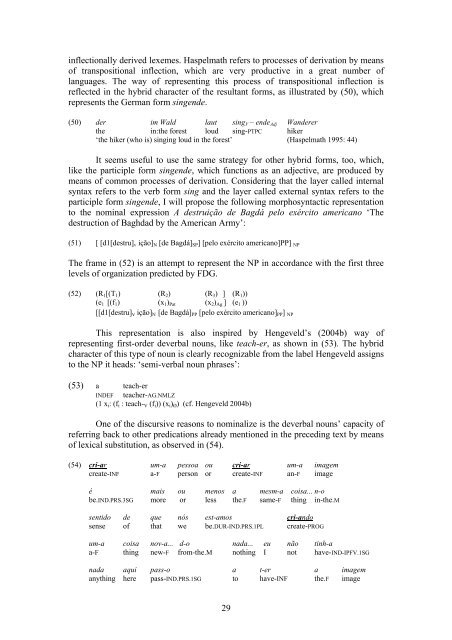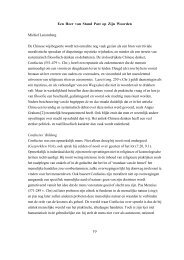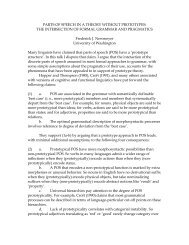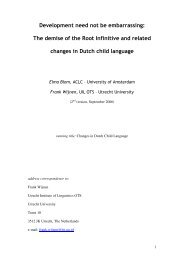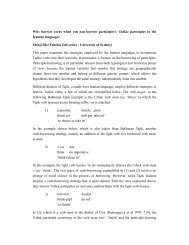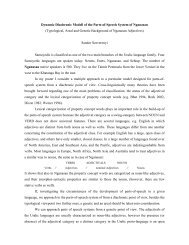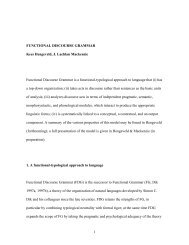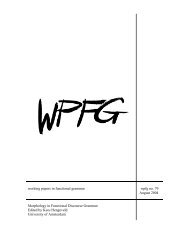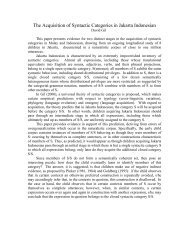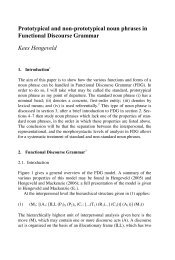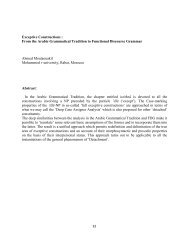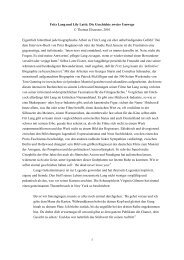The argument structure of deverbal nouns in Brazilian Portuguese
The argument structure of deverbal nouns in Brazilian Portuguese
The argument structure of deverbal nouns in Brazilian Portuguese
You also want an ePaper? Increase the reach of your titles
YUMPU automatically turns print PDFs into web optimized ePapers that Google loves.
<strong>in</strong>flectionally derived lexemes. Haspelmath refers to processes <strong>of</strong> derivation by means<br />
<strong>of</strong> transpositional <strong>in</strong>flection, which are very productive <strong>in</strong> a great number <strong>of</strong><br />
languages. <strong>The</strong> way <strong>of</strong> represent<strong>in</strong>g this process <strong>of</strong> transpositional <strong>in</strong>flection is<br />
reflected <strong>in</strong> the hybrid character <strong>of</strong> the resultant forms, as illustrated by (50), which<br />
represents the German form s<strong>in</strong>gende.<br />
(50) der im Wald laut s<strong>in</strong>gV – endeAdj Wanderer<br />
the <strong>in</strong>:the forest loud s<strong>in</strong>g-PTPC hiker<br />
‘the hiker (who is) s<strong>in</strong>g<strong>in</strong>g loud <strong>in</strong> the forest’ (Haspelmath 1995: 44)<br />
It seems useful to use the same strategy for other hybrid forms, too, which,<br />
like the participle form s<strong>in</strong>gende, which functions as an adjective, are produced by<br />
means <strong>of</strong> common processes <strong>of</strong> derivation. Consider<strong>in</strong>g that the layer called <strong>in</strong>ternal<br />
syntax refers to the verb form s<strong>in</strong>g and the layer called external syntax refers to the<br />
participle form s<strong>in</strong>gende, I will propose the follow<strong>in</strong>g morphosyntactic representation<br />
to the nom<strong>in</strong>al expression A destruição de Bagdá pelo exército americano ‘<strong>The</strong><br />
destruction <strong>of</strong> Baghdad by the American Army’:<br />
(51) [ [d1[destru]v ição]N [de Bagdá]SP] [pelo exército americano]PP] NP<br />
<strong>The</strong> frame <strong>in</strong> (52) is an attempt to represent the NP <strong>in</strong> accordance with the first three<br />
levels <strong>of</strong> organization predicted by FDG.<br />
(52) (R1[(T1) (R2) (R3) ] (R1))<br />
(e1 [(f1) (x1)Pat (x2)Ag ] (e1 ))<br />
[[d1[destru]v ição]N [de Bagdá]PP [pelo exército americano]PP] NP<br />
This representation is also <strong>in</strong>spired by Hengeveld’s (2004b) way <strong>of</strong><br />
represent<strong>in</strong>g first-order <strong>deverbal</strong> <strong>nouns</strong>, like teach-er, as shown <strong>in</strong> (53). <strong>The</strong> hybrid<br />
character <strong>of</strong> this type <strong>of</strong> noun is clearly recognizable from the label Hengeveld assigns<br />
to the NP it heads: ‘semi-verbal noun phrases’:<br />
(53) a teach-er<br />
INDEF teacher-AG.NMLZ<br />
(1 xi: (fi : teach-V (fi)) (xi)Ø) (cf. Hengeveld 2004b)<br />
One <strong>of</strong> the discursive reasons to nom<strong>in</strong>alize is the <strong>deverbal</strong> <strong>nouns</strong>’ capacity <strong>of</strong><br />
referr<strong>in</strong>g back to other predications already mentioned <strong>in</strong> the preced<strong>in</strong>g text by means<br />
<strong>of</strong> lexical substitution, as observed <strong>in</strong> (54).<br />
(54) cri-ar um-a pessoa ou cri-ar um-a imagem<br />
create-INF a-F person or create-INF an-F image<br />
é mais ou menos a mesm-a coisa... n-o<br />
be.IND.PRS.3SG more or less the.F same-F th<strong>in</strong>g <strong>in</strong>-the.M<br />
sentido de que nós est-amos cri-ando<br />
sense <strong>of</strong> that we be.DUR-IND.PRS.1PL create-PROG<br />
um-a coisa nov-a... d-o nada... eu não t<strong>in</strong>h-a<br />
a-F th<strong>in</strong>g new-F from-the.M noth<strong>in</strong>g I not have-IND-IPFV.1SG<br />
nada aqui pass-o a t-er a imagem<br />
anyth<strong>in</strong>g here pass-IND.PRS.1SG to have-INF the.F image<br />
29


